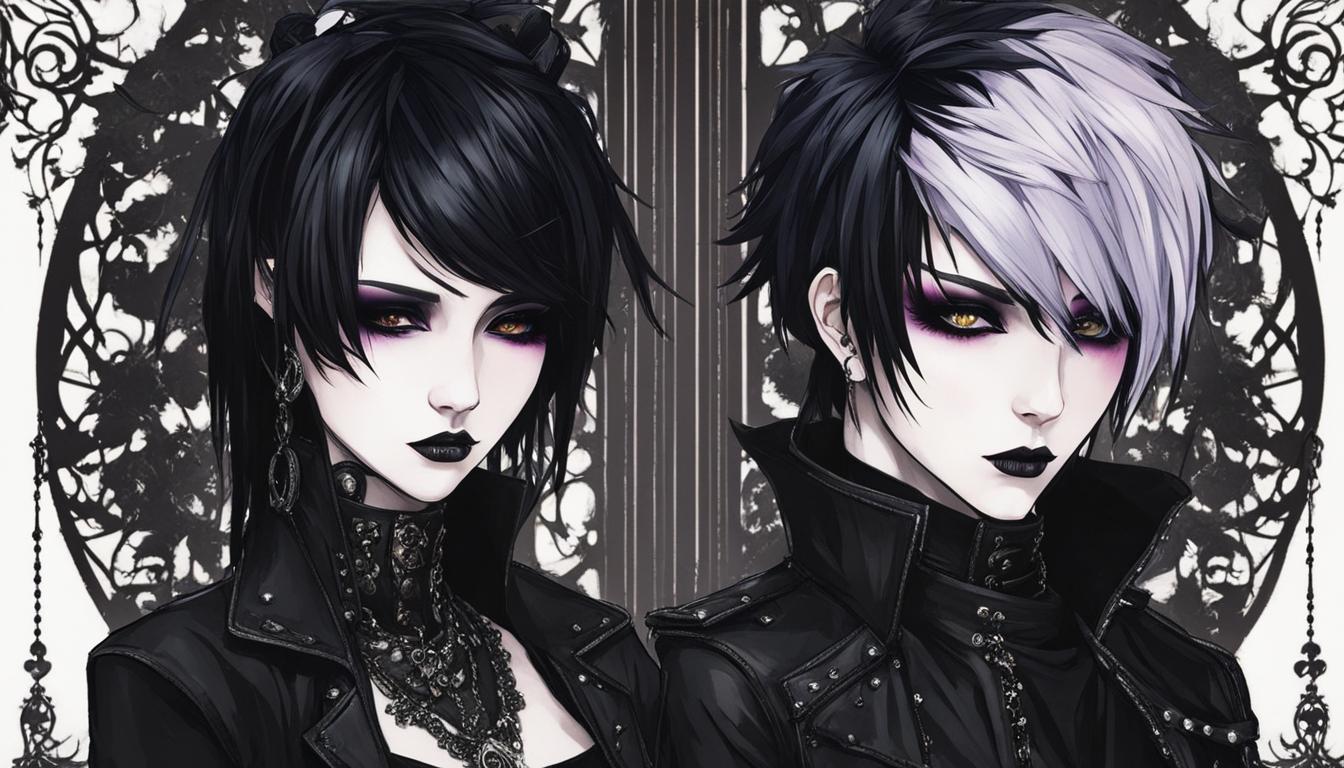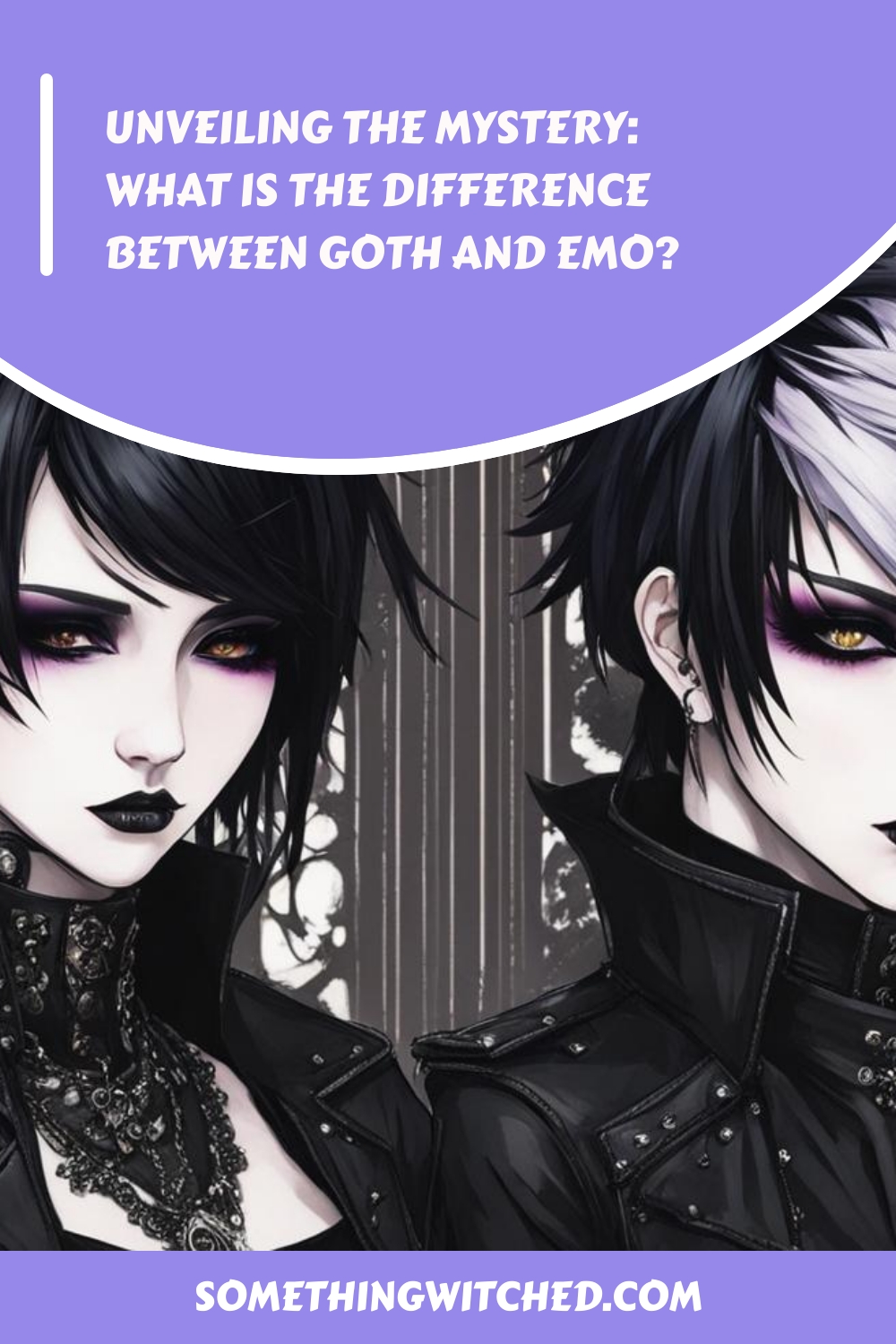Have you ever wondered what sets goth and emo apart? While these subcultures share some similarities, they also have distinct characteristics that make them unique. In this article, we will delve into the origins, fashion styles, music, and symbolism of goth and emo, shedding light on the key differences between the two. Whether you’re a goth enthusiast, an emo fan, or simply curious about subcultures, this article will help you understand what sets goth and emo apart.
Key Takeaways:
- Goth and emo are subcultures that share a focus on emotions but explore different themes.
- Goth originated from Gothic architecture and literature, while emo evolved from the hardcore punk scene.
- Goth fashion embraces dark, dramatic aesthetics, while emo fashion incorporates elements of grunge and punk.
- Symbolism in goth includes skulls, crosses, serpents, and roses, while emo focuses on emotional lyrics and personal themes.
- Goth and emo have influenced popular culture and have their own unique presence in music, literature, and film.
Goth Subculture: A Journey into the Dark and Mysterious
When exploring the world of goth, one cannot ignore its deep roots in gothic architecture and literature. The goth subculture, which emerged in the late 1970s, encompasses music, art, and fashion, but it is deeply influenced by the dark and emotional themes found in Gothic literature. Authors such as Mary Shelley and Edgar Allan Poe laid the foundation for the goth aesthetic, which embraces darkness, melancholy, and individualism.
Gothic architecture, with its grandeur and ornate details, serves as a visual inspiration for goth fashion and accessories like the Bracelet Goth. This architectural style, known for its pointed arches and intricate designs, creates a sense of mystery and awe, much like the goth subculture itself. The combination of gothic literature and architecture forms a unique subculture that delves into existential themes and invites individuals to explore their own darkness.
The Influence of Gothic Literature
“Gothic literature is the birthplace of goth subculture, with its haunting tales of vampires, ghosts, and supernatural creatures. It explores the darker aspects of human existence and provides a rich source of inspiration for goth fashion and music.” – Gothic enthusiast
Gothic literature’s influence on goth culture reaches far beyond fashion and aesthetics. The genre’s exploration of the macabre, the unexplainable, and the human condition resonates deeply with those who identify with goth. The eerie atmospheres, complex characters, and introspective themes found in Gothic literature serve as a constant reminder of the intricacies of life and the beauty found in darkness.
As goth subculture continues to evolve, it remains rooted in its origins in gothic architecture and literature. The combination of dark aesthetics, emotional vulnerability, and individualism sets goth apart as a unique and intriguing subculture that continues to captivate and inspire countless individuals.
Styles and Designs of Bracelet Goth
Bracelet Goth offers a diverse range of styles and designs to cater to various fashion sensibilities within the gothic realm. Whether you prefer a Victorian gothic aesthetic, a punk goth edge, a witchy goth vibe, or an industrial goth look, there is a bracelet style to suit your individual taste.
The Victorian gothic style embraces the elegance and grandeur of the Victorian era, featuring intricate patterns, lace, and dark gemstones. These bracelets exude a sense of old-world charm and sophistication, adding a touch of vintage glamour to any outfit.
For those seeking a rebellious and edgy look, punk goth bracelets are adorned with spikes, studs, and bold chains. These accessories make a bold statement, reflecting the defiance and individualism that is characteristic of the punk subculture.
Witchy goth bracelets draw inspiration from witchcraft and occult symbolism. Featuring pentagrams, moon phases, and mystical motifs, these bracelets embody the mysticism and spirituality associated with witchcraft and paganism.
If you prefer a more industrial and futuristic aesthetic, industrial goth bracelets incorporate elements inspired by machinery. Gears, screws, and other mechanical details are integrated into the design, creating a unique and avant-garde look.
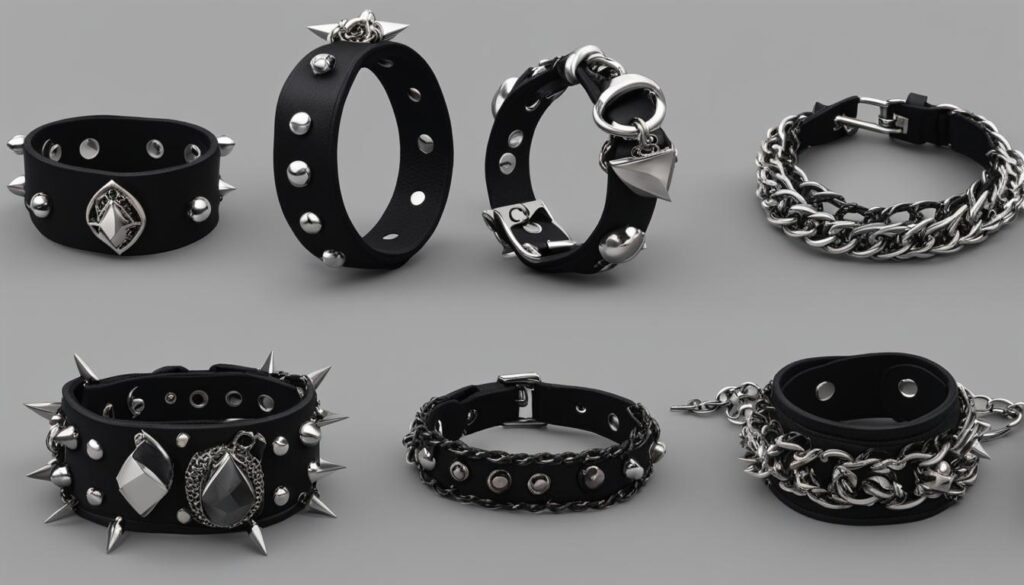
The Versatility of Bracelet Goth
One of the captivating aspects of Bracelet Goth is its versatility. These accessories can be mixed and matched with various gothic substyles and outfits, allowing for endless creative expression. Whether you lean towards a Victorian-inspired ensemble or embrace a more punk or witchy vibe, Bracelet Goth can complement your look and help you showcase your unique style.
By combining different bracelet styles, materials, and themes, you can create a personalized stack that reflects your individuality. Layering bracelets of different lengths and textures adds depth and interest to your ensemble, while incorporating contrasting elements such as lace and spikes creates a visually dynamic effect.
Furthermore, Bracelet Goth can also be seamlessly integrated into everyday fashion. You don’t have to reserve these accessories for special occasions or themed events. Embracing the gothic aesthetic in your daily attire allows you to express your style and identity confidently, even in a more casual setting.
Whether you’re attending a goth concert, exploring a haunted mansion, or simply going about your day, Bracelet Goth serves as a versatile and eye-catching addition to your ensemble.
Accessorize Your Gothic Look
Bracelet Goth is just one component of a complete gothic look. To fully embrace the gothic aesthetic, consider pairing your bracelets with other key elements such as dark clothing, statement jewelry, dramatic makeup, and unique accessories. These elements work together to create a cohesive and visually striking gothic ensemble.
Bracelet Goth offers a diverse range of styles and designs to cater to various fashion sensibilities within the gothic realm.
- Victorian gothic bracelets embrace elegance and grandeur, incorporating intricate patterns and dark gemstones.
- Punk goth bracelets feature spikes, studs, and bold chains for a rebellious and edgy look.
- Witchy goth bracelets draw inspiration from witchcraft and occult symbolism, incorporating pentagrams and moon phases.
- Industrial goth bracelets incorporate machinery-inspired elements like gears and screws for a futuristic aesthetic.
The versatility of Bracelet Goth allows for endless creative expression, as it can be mixed and matched with different gothic substyles and integrated into everyday fashion. By layering bracelets of various lengths and textures, you can create a personalized stack that reflects your individuality. Embracing the gothic aesthetic in your daily attire allows you to confidently express your style and identity, whether you’re attending a goth event or simply going about your day. Complete your gothic look by pairing your Bracelet Goth with dark clothing, statement jewelry, dramatic makeup, and unique accessories.
Symbolism and Meaning of Bracelet Goth
Bracelet Goth carries symbolic significance that resonates with the gothic subculture. Let’s explore some of the key symbols found in Bracelet Goth designs:
Skulls:
Skulls are a prominent symbol in gothic fashion, representing mortality and the transience of life. They reflect the subculture’s exploration of darkness and death. In Bracelet Goth designs, skulls can be intricately detailed or minimalist, depending on the desired aesthetic. They serve as a reminder to embrace the fleeting nature of life and find beauty in the macabre.
Crosses:
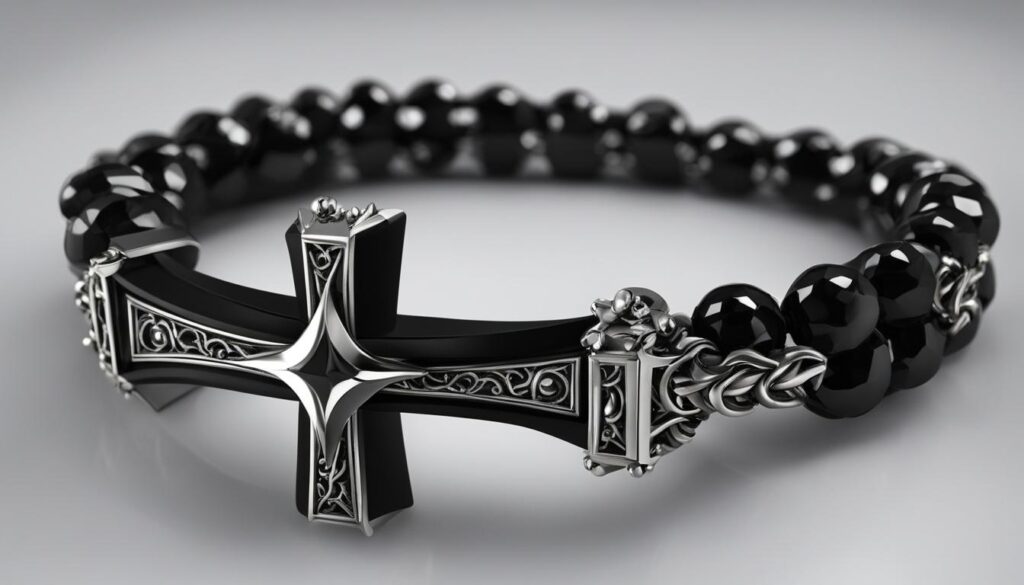
Crosses hold deep spiritual meaning and are often associated with gothic culture. In Bracelet Goth, crosses can symbolize faith and spirituality, connecting the subculture to the macabre and the supernatural. They serve as a reminder of the complex relationship between life and death and the gothic subculture’s exploration of the mystical and otherworldly.
Serpents:
Serpents are powerful symbols of rebirth, transformation, and the occult. In Bracelet Goth designs, serpents represent the subculture’s invitation to embrace hidden depths and explore the mysteries of the world. They symbolize the duality of life and the constant cycle of death and rebirth, inviting wearers to delve into their own personal transformations.
Roses:
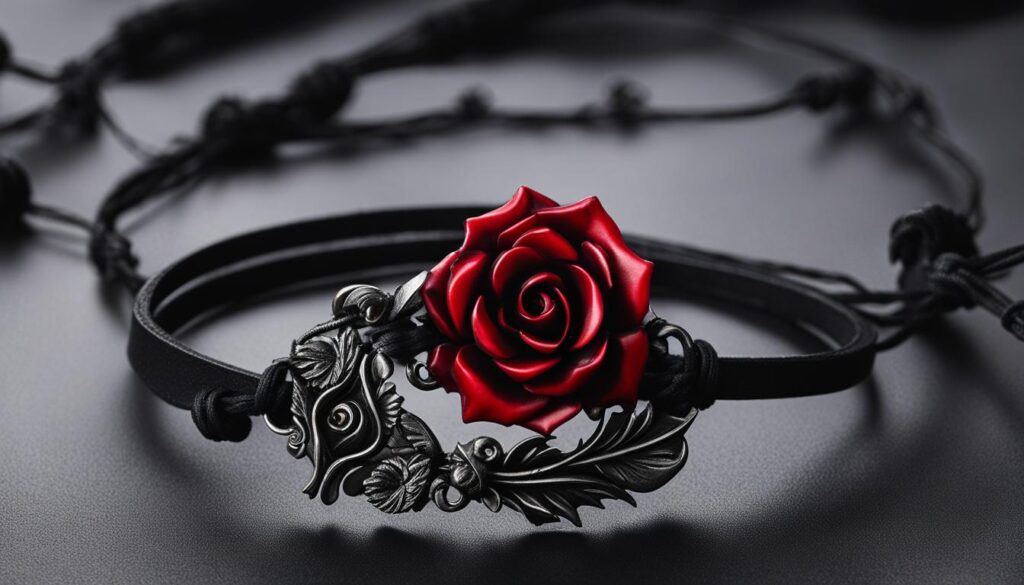
In gothic fashion, roses provide a striking juxtaposition to the dark aesthetic. They symbolize beauty, love, and passion, offering a contrasting element within the gothic subculture. Bracelet Goth often incorporates roses into designs to create an intriguing blend of darkness and beauty, allowing goth enthusiasts to express their emotions and desires through their jewelry choices.
These are just a few examples of the symbolic elements found in Bracelet Goth. Each symbol carries its own meaning and significance within the gothic subculture, allowing individuals to express their unique identity and embrace the mysteries of life.
Evolution and Modern Adaptations of Bracelet Goth
Bracelet Goth, like any fashion trend, has evolved over time to cater to modern tastes while still maintaining its dark elegance. As new subcultures and music genres emerged, Bracelet Goth adapted to incorporate elements from other styles, resulting in unique hybrid designs.
One significant influence on the evolution of Bracelet Goth is the emo subculture. Emo, with its emphasis on emotional expression and personal experiences, has influenced Bracelet Goth designs by introducing a more introspective and relatable aspect. Emo-influenced Bracelet Goth styles often incorporate symbols of heartache, such as broken hearts or teardrops, reflecting the emotional depth and vulnerability associated with the emo subculture.
Metal and grunge are two other genres that have contributed to the evolution of Bracelet Goth. Metal music, known for its dark and heavy sound, has influenced Bracelet Goth designs by incorporating elements such as spikes and chains, adding a sense of rebellion and edge. Grunge, with its raw and disheveled aesthetic, has influenced Bracelet Goth by embracing a more laid-back and casual style, often featuring distressed materials or unconventional materials.
Modern adaptations of Bracelet Goth have also taken inspiration from various other sources, resulting in a wide range of styles. Some designers have fused elements of classic goth fashion with contemporary streetwear, creating a unique blend of old and new. Others have incorporated elements from fantasy and sci-fi genres, adding a touch of mysticism and futurism to Bracelet Goth designs.
“Bracelet Goth has adapted to cater to modern tastes while retaining its dark elegance.”
Goth vs Emo: Understanding the Subcultures
Goth and emo, two subcultures that have captured the imagination of many, often cause a bit of confusion. At first glance, they may seem similar, both embracing emotions and a darker aesthetic. However, delving deeper, we can uncover the unique characteristics that set them apart. Let’s explore the key differences and similarities between goth and emo.
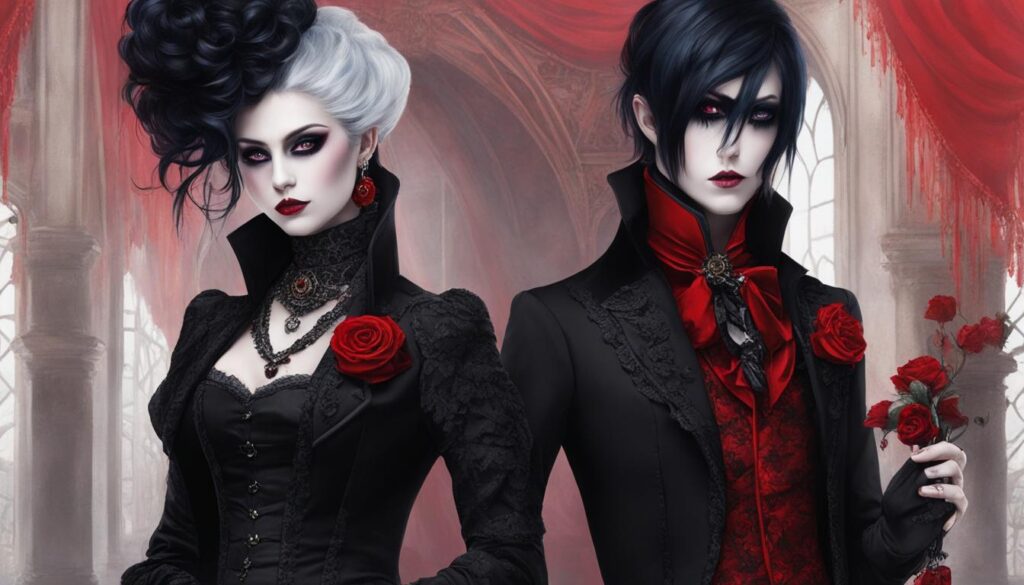
Key Takeaways:
- Goth and emo subcultures both focus on emotions and expressing one’s feelings.
- Goth delves into existential themes, whereas emo focuses on everyday heartache and happiness.
- Both goth and emo have influenced music, fashion, and popular culture.
- Gothic fashion embraces darkness and historical influences, while emo fashion combines grunge and punk aesthetics.
- Understanding the distinctions between goth and emo helps appreciate the unique qualities of each subculture.
The Origins of Emo
Emo originated as a style of hardcore punk and post-hardcore in the mid-1980s Washington, D.C. hardcore scene, known as emotional hardcore or emocore. Bands like Rites of Spring and Embrace pioneered the genre, combining the musical style of hardcore punk with melodic guitars and emotional, introspective lyrics. Emo later evolved and reinvented itself in the early to mid-1990s, influenced by alternative rock, indie rock, punk rock, and pop-punk bands.
Emo music emerged as a way for musicians to express their innermost thoughts and emotions. It became a platform for vulnerability and introspection, with lyrics often delving into personal experiences of heartbreak, self-doubt, and loneliness. The emotional intensity of the music resonated with many listeners, especially young people navigating the complexities of adolescence and relationships.
Emo’s popularity grew throughout the 1990s and early 2000s, reaching its peak in the mainstream with bands like Jimmy Eat World, Dashboard Confessional, and My Chemical Romance. The genre’s appeal extended beyond the music itself, influencing fashion, aesthetics, and overall cultural identity. Today, emo continues to thrive as a genre, with new artists incorporating elements of emo into various styles of music.
Characteristics of Emo Music
Emo music is known for its distinctive characteristics that set it apart from other genres. With its emotional lyrics and confessional themes, emo music connects with listeners on a deep and personal level. The genre draws influences from punk rock, post-hardcore, and alternative rock, creating a unique sound that resonates with fans around the world.
At the heart of emo music are its lyrics, which often explore topics such as failed romance, self-loathing, pain, insecurity, and love. These emotional and introspective lyrics allow listeners to relate to the music and find solace in the shared experiences of the artists. Whether it’s free-associative poetry or intimate confessionals, emo lyrics invite listeners into a world of vulnerability and raw emotion.
The musical style of emo also contributes to its distinctiveness. Emo combines the softness and introspection of punk rock with elements of post-hardcore and alternative rock. Some bands incorporate progressive musical elements, complex guitar work, and unorthodox song structures, pushing the boundaries of the genre and creating a dynamic listening experience for fans.
Overall, emo music is more than just a genre—it’s a form of self-expression and catharsis. Through its emotional lyrics and confessional themes, emo connects with listeners on a deeply personal level, providing comfort and understanding in a world of complex emotions.
Evolution and Popularity of Emo
The emo subculture and its associated music, fashion, and attitude gained significant mainstream popularity in the early 2000s. Emo pop bands like Jimmy Eat World and Dashboard Confessional achieved commercial success, and the genre became a prominent presence in popular culture. Many emo artists signed with major record labels, and their music resonated with a wide audience. Emo’s emotional lyrics and confessional themes struck a chord with listeners, who found solace and identification in the music.
Throughout the 2000s, emo continued to gain popularity, with bands like My Chemical Romance, Fall Out Boy, and The Red Jumpsuit Apparatus dominating the charts. These bands brought emo music to the forefront, capturing the hearts of both emo subculture members and mainstream listeners.
However, by the early 2010s, emo’s popularity began to decline in the mainstream. The genre faced criticism for its association with teenage angst and emotional expression. Emo’s decline in popularity led to a shift in the music industry, with other genres taking center stage.
But like many subcultures, emo experienced a revival in the late 2010s. The emo revival movement brought a renewed interest in the sound and aesthetic of 1990s emo. Bands like American Football, Modern Baseball, and The Hotelier emerged, drawing inspiration from the original emo scene while adding their own modern twists. The emo revival attracted both nostalgic listeners and a new generation of fans, reigniting the passion for emo music and culture.
Exploring Goth and Emo Fashion
Goth and emo subcultures have distinct fashion styles that allow individuals to express their unique identities. While both styles share some similarities, they also have their own defining characteristics. Let’s take a closer look at goth and emo fashion and the elements that set them apart.

Key Takeaways:
- Goth fashion embraces dark, dramatic aesthetics and draws inspiration from historical influences like Victorian-era elegance, industrial aesthetics, and witchcraft.
- Emo fashion leans towards a more casual, laid-back style with elements of grunge and punk, often incorporating band merchandise.
- Goth subculture has various fashion substyles, including romantic goth, industrial goth, graver, and modern bruja.
- Common misconceptions about goth culture include assumptions about depression and the inability to find happiness, whereas many goths embrace their darkness and find joy within their chosen aesthetic.
- Goth culture has influenced popular culture and literature, with goth imagery often appearing in vampire movies and gothic literature playing a significant role in the subculture’s origins.
Gothic Fashion Substyles
Within the goth subculture, there are various fashion substyles that individuals may identify with. These substyles offer unique aesthetics and allow goths to express their personal style while remaining true to the broader gothic culture.
Romantic Goth
One popular gothic fashion substyle is romantic goth, which embodies the classic goth look with a romantic twist. This substyle often features lace, corsets, and elaborate jewelry, drawing inspiration from Victorian-era elegance. Romantic goth fashion emphasizes the beauty in darkness and showcases intricate details that evoke a sense of mystery and allure.
Industrial Goth
Industrial goth is another prominent substyle within the gothic fashion realm. Inspired by German expressionism and industrial aesthetics, industrial goth fashion incorporates vinyl or latex clothing, as well as an array of piercings. This substyle is characterized by its bold, edgy look and often includes unique accessories like gas masks or harnesses.
Graver
Graver is a substyle that combines the dark aesthetics of goth with the bright and playful elements of EDM culture. It embraces neon accents, vibrant colors, and cartoonish imagery, creating a striking and energetic look. Graver fashion is known for its boldness and versatility, allowing individuals to express their creativity in a vibrant and unconventional way.
Modern Bruja
The modern bruja substyle is a relatively recent addition to the gothic fashion scene. It draws inspiration from folk witchcraft and combines it with everyday wear. Modern bruja fashion incorporates natural materials, earthy tones, and a touch of mysticism. It emphasizes simplicity and comfort while still maintaining the core goth aesthetic.
Common Misconceptions about Goth
There are several common misconceptions about goth culture that often overshadow the true essence of this vibrant and diverse subculture. While goths are often associated with a fascination with death and the darker side of life, it is important to understand that not all goths are depressed or consumed by negativity. In fact, many goths find solace and happiness within their chosen aesthetic and subculture.
Contrary to popular belief, goths can have a sense of humor and enjoy lighthearted moments. Self-deprecating humor is prevalent within the goth community, as individuals embrace their quirks and the unique aspects of their subculture. It is through this humor that goths find common ground and build strong connections with like-minded individuals.
Goth culture is multifaceted and encompasses a wide range of interests and experiences. While some goths may explore themes of darkness and introspection, others celebrate individuality, creativity, and self-expression. They find joy in the artistic expression of their fashion choices, the connection forged through music, and the camaraderie of the goth community.
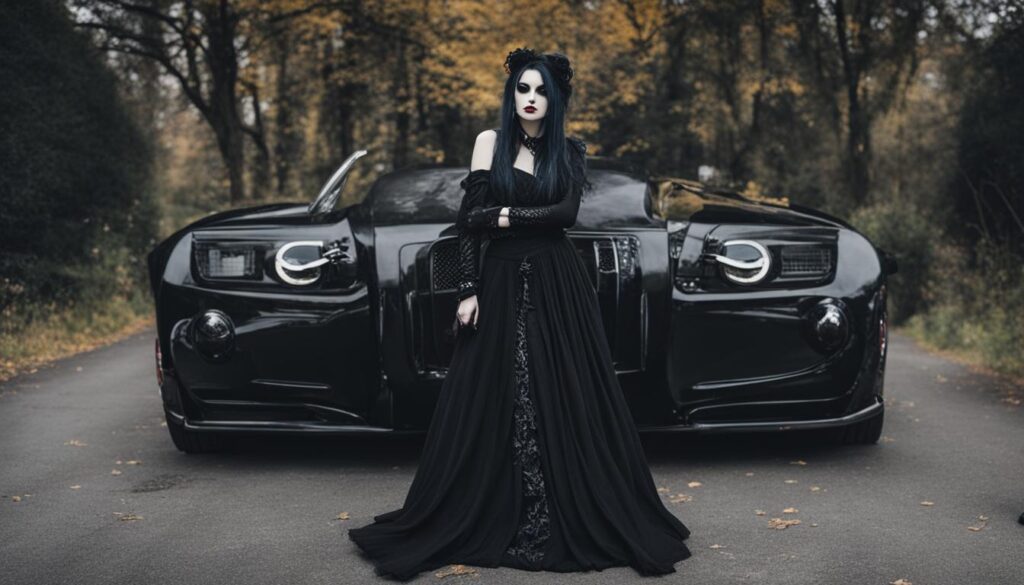
“Goth culture is not about wallowing in sadness, but rather embracing the beauty that can be found in life’s darker aspects.” – Alyssa, Goth enthusiast
It is important to challenge the stereotypes associated with goth culture and recognize that happiness can be found in the exploration of darkness. Goths find solace in the embrace of their authentic selves and the celebration of their unique interests, forging a community that supports and uplifts one another. So let go of preconceived notions and discover the vibrant and diverse world of goth culture.
Goth in Pop Culture and Literature
Goth culture has had a significant impact on various aspects of popular culture, including literature, music, and film. Gothic literature, with its dark and mysterious themes, plays a prominent role in goth’s origins. Works such as Bram Stoker’s Dracula have become iconic and have shaped the goth aesthetic and mythology. These literary contributions have influenced not only goth subculture but also gothic imagery in popular media.
“Gothic fiction is the realm of dark castles, haunted mansions, and tortured souls. It taps into our fascination with the macabre and explores the depths of human fear and desire.” – Gothic literature expert
In pop culture, goth imagery is often associated with vampire movies and supernatural themes. The dark and mysterious atmosphere of gothic aesthetics is frequently depicted in films featuring vampires, adding to the allure and mystique of the subculture. Additionally, goth culture has inspired various subgenres and adaptations, such as Christian goth, which combines goth aesthetics with Christian spirituality.
The Influence of Goth in Media
Goth’s influence extends beyond literature and film, permeating through different forms of media. Goth music, with its melancholic and introspective lyrics, has played a significant role in shaping alternative and rock music genres. Bands such as The Cure, Bauhaus, and Siouxsie and the Banshees are widely recognized as pioneers of goth music, and their influence can be seen in contemporary alternative and rock artists.
Furthermore, goth fashion has made a mark in the fashion industry, with its dark and dramatic aesthetics being embraced by designers and fashion enthusiasts. The goth subculture’s unique style has been featured in runway shows, editorials, and streetwear. From Victorian-inspired lace and corsets to industrial-inspired vinyl and latex, goth fashion continues to inspire and influence the world of fashion.
Overall, goth culture’s presence in pop culture and literature has left an undeniable impact, shaping various art forms and capturing the fascination of many. Whether it’s the eerie charm of gothic novels or the captivating aesthetics of goth fashion, the influence of goth in popular culture continues to resonate and inspire.
Whitby and its Significance to Goth Culture
The coastal town of Whitby in the United Kingdom holds a special place in the hearts of goth enthusiasts. This picturesque town, with its gothic architecture and hauntingly beautiful atmosphere, has become synonymous with the goth subculture. One of the key reasons for Whitby’s significance is its connection to Bram Stoker’s iconic novel, Dracula.
In Bram Stoker’s Dracula, Whitby serves as a pivotal location in the story, where the Demeter ship runs aground and Count Dracula transforms into a wolf to escape the town. These scenes, vividly described in the novel, have captured the imaginations of goth enthusiasts worldwide. Whitby’s dark and mysterious ambiance, coupled with its historical ties to vampire mythology, make it a must-visit destination for those seeking to immerse themselves in goth culture.
For goth fans and literary tourists alike, Whitby offers a chance to walk in the footsteps of the characters from Dracula and experience the haunting allure of the town. From the atmospheric Whitby Abbey perched on the cliffs to the cobbled streets and gothic architecture, Whitby provides a perfect backdrop for goths to embrace their fascination with the macabre and indulge in the gothic aesthetic that inspires them.
Whether you’re a fan of goth culture or simply appreciate the eerie beauty of Whitby, a visit to this charming town will undoubtedly leave a lasting impression. From exploring the sites mentioned in Bram Stoker’s Dracula to soaking in the unique atmosphere, Whitby offers a journey into the heart of goth culture and its enduring connection to the world of literature and the supernatural.
FAQ
What is the difference between goth and emo?
Goth and emo are both subcultures that focus on emotions, but goth delves into existential themes while emo centers on everyday heartache and happiness.
What is the origin of goth?
The goth subculture originated in the late 1970s and is influenced by Gothic architecture and literature.
What are the different styles and designs of Bracelet Goth?
Bracelet Goth comes in various styles, including Victorian gothic, punk goth, witchy goth, and industrial goth.
What do the symbols on Bracelet Goth represent?
The symbols on Bracelet Goth, such as skulls, crosses, serpents, and roses, hold symbolic significance related to mortality, spirituality, rebirth, and beauty.
How has Bracelet Goth evolved over time?
Bracelet Goth has adapted to modern tastes and incorporated elements from other subcultures like emo, metal, and grunge, resulting in hybrid styles.
What are the similarities between goth and emo?
Both goth and emo share a focus on emotions and being open about one’s feelings.
What is the origin of emo?
Emo originated as a style of hardcore punk and post-hardcore in the mid-1980s Washington, D.C. hardcore scene.
What are the characteristics of emo music?
Emo music is characterized by emotional and confessional lyrics, dealing with topics such as failed romance, self-loathing, and love.
How has emo evolved over time?
Emo entered mainstream culture in the early 2000s and experienced a revival in the late 2010s, drawing inspiration from 1990s emo.
How does goth fashion differ from emo fashion?
Goth fashion is characterized by dark and dramatic aesthetics, while emo fashion incorporates elements of grunge and punk styles.
What are the different gothic fashion substyles?
Gothic fashion encompasses various substyles, including romantic goth, industrial goth, graver, and modern bruja.
What are some common misconceptions about goth culture?
While goths often think about dark subjects, not all goths are depressed. Goth culture is multifaceted, and stereotypes do not define all individuals within the subculture.
How has goth influenced popular culture and literature?
Goth culture has influenced various aspects of popular culture, including literature, music, and film, with goth imagery often appearing in vampire movies.
What is the significance of Whitby to goth culture?
Whitby, a British seaside town, holds significance in goth culture due to its connection to Bram Stoker’s novel, Dracula, and its gothic atmosphere.
